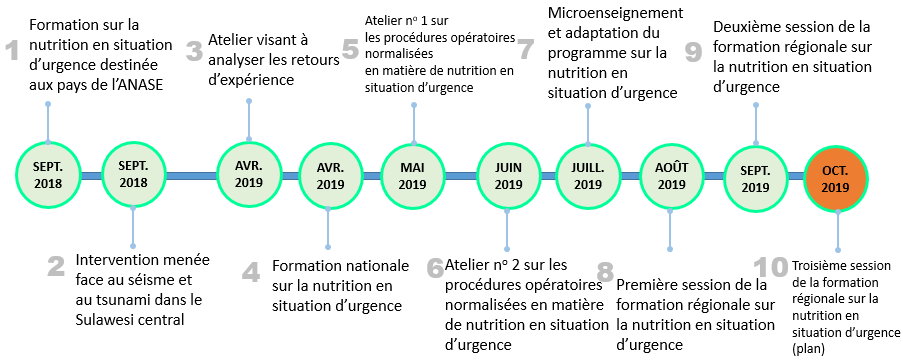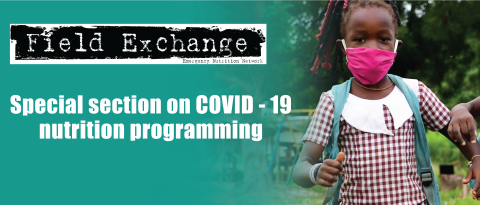Multi-sector nutrition programming: ‘Nutrition Smart Villages’ in Bangladesh and India
This is a summary of a Field Exchange field article that was included in issue 65. The original article was authored by Sweta Banerjee
Sweta Banerjee is the Nutrition Specialist for Welthungerhilfe’s India country programme.
Nutrition Smart Villages took a multi-sector approach to address the multiple causes of undernutrition by improving agricultural, water, sanitation and hygiene (WASH) and nutrition and care practices through community led activities and by empowering households to access government entitlements.
- Between the baseline and endline (one year apart) surveys, there were improvements in women’s and children’s dietary diversity and WASH practices in the project areas.
- Poorer child nutritional outcomes in India were attributed to a range of factors including women’s heavier workload, social taboos, dietary composition and a very long dry spell.
- Key lessons learned are the need to create an enabling environment for behaviour change, the need to integrate programming into existing institutions and government services and the need to strengthen government systems to find ways to overcome capacity gaps.
Background
Undernutrition among children and women of reproductive age is a major public health problem in India and Bangladesh. This article describes the Nutrition Smart Village project, a multi-sector approach used in rural villages in Bangladesh and India by Welthungerhilfe (WHH) that aimed to address the multiple causes of undernutrition by improving agricultural, water, sanitation and hygiene (WASH), nutrition and care practices through a holistic community-led approach. This approach helped communities to understand nutrition in practical terms as well as to demonstrate to local government how existing government schemes could be converged at household level to target support to those most vulnerable to undernutrition. The hypothesis is that if families understand their nutrition situation, have control over their own resources and are empowered enough to create a demand for their entitlements, then their members will be able to achieve optimal nutrition.
Programme description
In India and Bangladesh, the Nutrition Smart Villages project was implemented in 100 villages in two districts in Central India and 100 villages in three districts in Bangladesh for 24 months (September 2018 to August 2020). Project areas were targeted based on social and geographical exclusion, landlessness and other social vulnerabilities. WHH’s India and Bangladesh offices implemented the programme through local non-governmental organisations (NGOs).
Village-level interventions
Linking agriculture and natural resource management towards nutrition security: Meetings were held within the villages where community members learned about agricultural practices and natural resource management to support nutrition, childcare and WASH practices.
Sustainable integrated farming systems: Families were encouraged to develop nutrition gardens which included the cultivation of crops, trees, fisheries, aquatic birds and livestock using sustainable agricultural techniques.
Nutrition-sensitive micro planning: Elected village members were trained in nutrition-sensitive micro planning skills after which they worked with villages to develop plans that focused on the needs of families with undernourished women and children.
Nutrition behaviour change campaigns: The government service providers, along with volunteers and local self-help group1 (SHG) members, were trained to measure child (aged 6-36 months) anthropometry. Caregivers of children identified as undernourished received counselling on infant and young child feeding, hygiene and care practices and could attend 15-day positive deviance camps through which they received demonstrations of care practices, low-cost nutritious food recipes, nutrition gardening and food preservation for lean periods.
Strengthening institutions: Existing village institutions, SHGs and local committees within the village were strengthened by the project facilitators to understand government entitlements and how to access these. Members of the village institutions were also engaged in other village level activities.
Meso- and macro-level interventions
Partner NGOs developed knowledge management platforms to facilitate exchanges between communities, policymakers and partner organisations, build the capacity of elected representatives and lobby government on policy development.
Results
A baseline survey was carried out prior to implementation followed by an endline survey after 12 months. Due to budget limitations, the survey was restricted to 50% of the project villages where a random sample of 1,186 households with children aged 6-36 months was selected. Compared to baseline, favourable endline outcomes were observed in Bangladesh and India for child nutrition status, women’s and children’s dietary diversity and WASH behaviours (Figure 1). The only outcome that did not appear to improve was child wasting (6-36 months) in India where prevalence rose from 18% to 22%.
Figure 1: Baseline (2019) versus endline (2020) findings of the Nutrition Smart Villages project in India and Bangladesh

MDDW: minimum diet diversity for women
MDDC: minimum diet diversity for children
Discussion
Over the course of one year, substantial gains were seen in the project areas in terms of improved dietary diversity of women and children and WASH outcomes. As there was no control group, changes could not be attributed to the programme although improvements in the participants’ quality of life were readily observed by partners. The short project implementation period may have led to limited gains in child nutritional status.
Overall, India had poorer child nutritional outcomes compared to Bangladesh. Possible factors driving this include:
- Women in Central India are more heavily engaged in labour activities that may compromise infant feeding practices
- Variations in diet composition, particularly protein sources
- Strong social taboos and myths affecting complementary feeding practices
- The very long dry spell in Central India which affected the ability of many households to support dietary diversity
Lessons learned from this programme include:
- Increased knowledge can only translate into new behaviours in the context of an enabling environment.
- To be successful, multi-sector programmes must be designed to integrate into existing community-level institutions and link to existing government schemes.
- The lack of staff at grassroots level is a major constraint to realising full government services.
- Strengthening local institutions and financially supporting volunteers were found to be a suitable stopgap in this context.
- The collection of data is important to enable the proper monitoring of progress.
Going forward, activities in the project villages will focus on sustaining new behaviours and achieving the ‘last mile’ before partners gradually phase out. The focus will be on
In India:
- Reducing women’s engagement in work outside the household
- Building skills to ensure sustainable dietary diversity and increased meal frequency for children
In Bangladesh:
- Scaling up the programme through government systems
- The creation of knowledge management platforms for experience sharing and the exchange of tools
- Piloting of a mobile-based data collection and management system that will share information with government institutions.
For more information, please contact Sweta Banerjee at Sweta.banerjee@welthungerhilfe.de
1 SHG – Self-help groups (SHGs) are informal associations of people who choose to come together to find ways to improve their living conditions.


